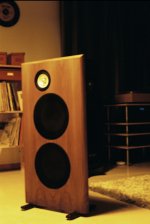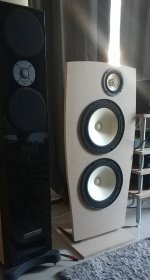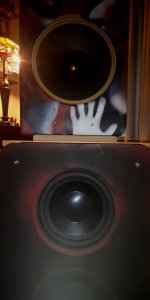I know the conversation has moved on, but I’m stuck wondering what a fractal flavoured ice cream cone looks like…
The article doesn’t explain what the gap does. Anybody know?Your system looks good. The baffles seem close to the front wall. Is it intentional/does it sound better that way?
Can I ask you a link to Leon's article you mentioned? I have wondered about the gap between panels.
Modular OB construction allows gaps between modules. This allows the possibility of vibration control so eg the woofer resonance does not smear the mid range. A bonus is ease of dismantling and swapping modules. A potential negative would be loss of sealed baffle area with low frequency cancellation. If the gaps are very small the leakage would be expected to be negligible with no discernable bass attenuation.
Disclaimer: I just made that all up 🙂
Reference: none 🙁
Modular OB construction allows gaps between modules. This allows the possibility of vibration control so eg the woofer resonance does not smear the mid range. A bonus is ease of dismantling and swapping modules. A potential negative would be loss of sealed baffle area with low frequency cancellation. If the gaps are very small the leakage would be expected to be negligible with no discernable bass attenuation.
You could add a think neoprene/rubber gasket between panels to seal them acoustically while avoiding the transfer of vibration.
How does your OB sound Ceiling hangingYes, we do, occasionally. My ceiling-suspended OB speakers are great and I only slapped them together with dumb luck at first, with tweaking over time mostly by ear. I ran them for a while with MiniDSP 2x4HD, but graduated to first order passive crossovers plus software EQ in the current configuration.
Even a broken clock is right twice per day.
I think they sound great, honestly. Not as good as my Manzanitas, but very enjoyable. They are oriented so that the best listening position is about 8 feet away.
These are full range speakers, there are also widerange series and Field Coil speakers.
If you are interested, please write to me : info@sonido.hu
I will send you the detailed list.
If you are interested, please write to me : info@sonido.hu
I will send you the detailed list.
I sized by trial and error the full range baffles size to act like a high pass filter when placed on stands.View attachment 1093994
View attachment 1093996
Modular OB construction allows gaps between modules. This allows the possibility of vibration control so eg the woofer resonance does not smear the mid range. A bonus is ease of dismantling and swapping modules. A potential negative would be loss of sealed baffle area with low frequency cancellation. If the gaps are very small the leakage would be expected to be negligible with no discernable bass attenuation.
Disclaimer: I just made that all up 🙂
Reference: none 🙁
Leaving a little gap allows a little dip in lieu of a crossover to the bass baffles.
This gives a natural sounding blend while setting the 4th order plate amp lowpass at about 95 hertz.
Post script- there's a fair bit more apparent gap width than what appears in the phone camera close up photo.
Attachments
I’ve got 4 of those. I plan on trying them in a naked clam shell arrangement, suspended. Got a pair of K2 amps to drive them.i had bms 18n862´s naked ob and it did reasonable loud down to 30hz, it was loud enough for me at least.
trying them in a naked clam shell arrangement, suspended
Blimey! Four BMS 18N862. That should do the job: 4woofers x 18 ″ x Xmax:19mm x2 for a total peak to peak displacement of 9.25L.
What frequency band are you thinking of?
I’ll try them initially over 30hz-150hz, but I intend playing around with that and seeing how high they will go without compromising the SQ.
Good plan. A hard cut at 30Hz should protect the woofers but what is the Xdamage for the BMS 18" woofer? The BMS looks designed for box back pressure so with OB it could easily max out. With clam pressure coupling and high power amps its something to beware of. Is there a way to prevent bottoming out?I’ll try them initially over 30hz-150hz, but I intend playing around with that and seeing how high they will go without compromising the SQ
Yeah they are too expensive to trash ! The people who have implemented the clam shell configuration do so with them acoustically in phase so that the cones move in the same direction at the same time. The pressure between the cones should not therefore increase.
Yeah they are too expensive to trash ! The people who have implemented the clam shell configuration do so with them acoustically in phase so that the cones move in the same direction at the same time. The pressure between the cones should not therefore increase.
I looked at the price. Shite. Definitely its a good idea to protect them. The clam arrangement with the drivers moving in unison means they assist each other. Theres about 50% less air resistance over a standard OB which is obviously much less then the intended box with pressure braking. So the clams are the perfect way to bottom and destroy a driver. The drivers assist and push each other into mutually assured destruction.
Do a search. I bet some have trashed woofers with clams. But it would take a brave person to admit to doing that so maybe its unheard of?
If I were you Id use the paper X-displacement-o meter that Siegfried Linkwitz discussed, to work out X-max vs freq with your amps and then put in a protective high pass. By keeping the woofers below X-max you keep HD under control and have a safety margin in term of X-damage.
Here my two new OB projects, as a first teaser only a few photos.
1.
Sheldon the egg right side and left side



2.
VoiceHorn4Desktop


1.
Sheldon the egg right side and left side
2.
VoiceHorn4Desktop
Last edited by a moderator:
Did you turn the midrange horns yourself?Here my two new OB projects, as a first teaser only a few photos.
1.
Sheldon the egg right side and left side
View attachment 1095888
View attachment 1095891View attachment 1095892
2.
VoiceHorn4Desktop
View attachment 1095889
View attachment 1095890
- Home
- Loudspeakers
- Multi-Way
- Ultimate Open Baffle Gallery




